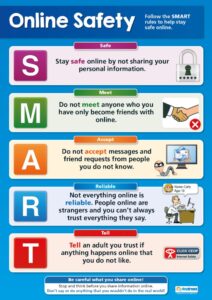During my schooling, the approach to cyber safety and digital citizenship was somewhat rudimentary and often reactive. Some of the main techniques included scare tactics, basic education on proper use, acceptable polices. Getting into scare tactics. We were often shown videos or given talks about the dangers of the internet, emphasizing worst case scenarios such as cyberbullying, identity theft, and encounters with online predators. These presentations were designed to instill fear and caution in my opinion. We also occasional had lessons or presentations going over basic education on proper usage. Lessons and presentations on the basics of safe internet use, such as not sharing personal information online, creating strong passwords, and being cautious about whom we interact with on social media. I know at some schools not any of mine though. The students had to sign different polices for internet based activities and such. Which outlined what was and wasn’t allowed, though these were often not thoroughly explained from my understanding.
Effectiveness of these approaches can change from person to person in saying that I will go over the effectiveness of each of the three approaches I mentioned. Starting with scare tactics. While scare tactics did succeed in making us wary of potential dangers, they also often led to a heightened sense of fear without providing practical strategies for safe and positive online behavior. This approach could sometimes cause anxiety and did not encourage responsible use or digital citizenship. Or students would still end up going against the approach because they wanted to almost prove the staff wrong in a sense like ”you don’t know what you are talking about this can’t happen me.” Now to some extent I do think the basic education on proper use did help. In saying that though it often lacked depth and continuity. It provided foundational knowledge but did not evolve with the rapidly changing digital landscape or address the more complex aspects of digital citizenship especially throughout my high school experience this was evident. Lastly with the signing policies. I always personally thought the policies were more about compliance than education. They ensured that students followed certain rules but did not foster a deep understanding of why those rules were important or how to navigate digital spaces thoughtfully and ethically.
Based on my experience the best practices used or that I have seen or heard of are. Continuous integration of education, critical thinking skills and ethical use, and positive guidance. For continuous integration I mean that digital citizenship education should be an ongoing part of the curriculum, integrated into various subjects rather than taught as isolated units. This helps students see the relevance of digital citizenship in all areas of their lives. Furthermore for critical thinking skills I mean that we should be encouraging critical thinking skills about the digital content they consume and create is crucial. Students should learn about ethical considerations, such as respecting others privacy, understanding the consequences of digital actions, and the importance of digital etiquette. I also talked about scare tactics that in my opinion weren’t the best method. For me what I would prefer is instead of relying on scare tactics, educators should provide practical guidance on safe and responsible online behavior. This includes teaching students how to evaluate online sources, understand digital footprints, protect their privacy, and engage in positive digital communication.
Lastly cyber safety and digital citizenship education must be comprehensive, continuous, and positive to be truly effective. Here is also a website that you could show your students down the road with some positive helpful tips to unsure they are safe! 15 Internet Safety Tips and Internet Safety Rules | Kaspersky
helpful tips to unsure they are safe! 15 Internet Safety Tips and Internet Safety Rules | Kaspersky